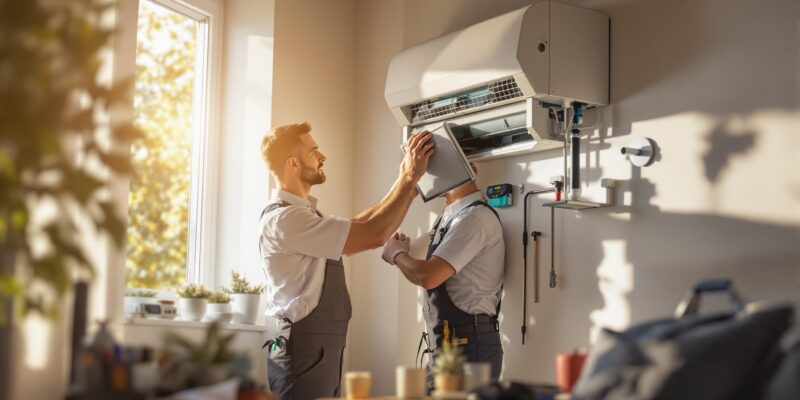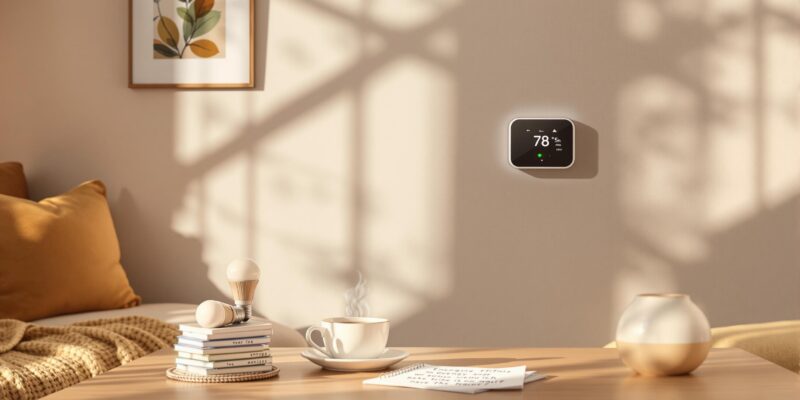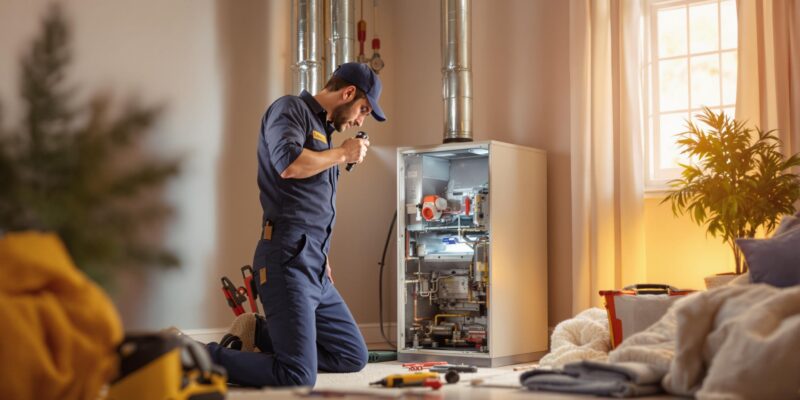Your thermostat is the control center of your HVAC system, ensuring your home stays comfortable year-round. If it malfunctions, your heating or cooling system may stop working efficiently. Here’s a quick guide to fixing common thermostat problems:
- Reset the Thermostat: Turn off power, follow reset instructions for your model, and reprogram settings.
- Replace Batteries: Weak or dead batteries often cause issues. Replace them annually or when you notice dim screens or alerts.
- Clean Internal Components: Dust buildup can affect performance. Turn off the power, remove the cover, and gently clean with a soft brush.
- Check Wiring: Look for loose, corroded, or damaged wires. Tighten connections or call a professional if needed.
- Verify Placement: Ensure the thermostat is on an interior wall, away from heat sources, drafts, or direct sunlight.
- Calibrate for Accuracy: Compare readings with a thermometer and adjust settings if necessary.
If these steps don’t resolve the issue, persistent problems like blank screens, short cycling, or wiring concerns may require professional help. Licensed HVAC technicians can diagnose and fix complex issues safely.
How to Troubleshoot a Thermostat | The Home Depot
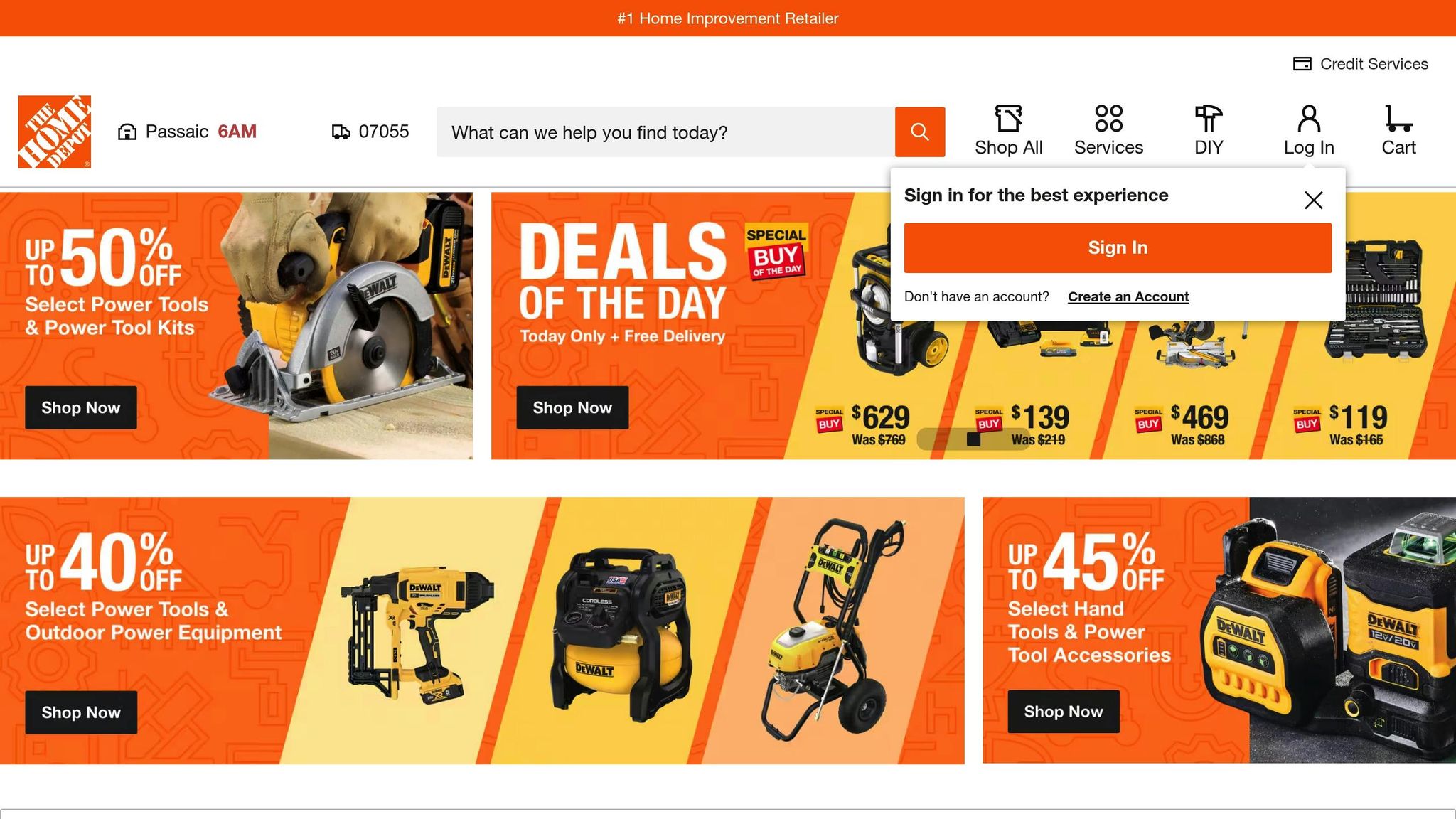
Step-by-Step Thermostat Troubleshooting Process
Before diving into complex fixes, start with the basics: resetting your thermostat, checking the batteries, and inspecting wiring or sensor placement. These steps are organized from the simplest to the more involved solutions.
How to Reset Your Thermostat
Resetting your thermostat can fix issues like unresponsive displays, programming errors, or incorrect temperature readings. Essentially, this process restores the thermostat to its factory settings, clearing minor glitches that might be causing problems.
To reset, first, turn off the power at the circuit breaker. Then, follow the specific reset instructions for your thermostat model. For instance:
- Honeywell Thermostats: Press the system button, hold the blank box in the center, and then press “done”.
- Nest Thermostats: Press and hold the outer ring for 10 seconds until the screen shuts off, then release and press it again. The Nest logo will appear, confirming the reset.
- Carrier Thermostats: Select “mode” on the main screen, set it to “off”, turn off the circuit breaker for 30 seconds, and then turn it back on. Finally, set the thermostat to your desired mode.
- Trane Smart Thermostats (XL824, ComfortLink® II 850/1050, Link UX360): Make sure the HVAC system is idle, then navigate to Menu > Settings > Reboot on the thermostat screen and confirm. Alternatively, you can turn off the circuit breaker for 20–30 seconds and then switch it back on.
After resetting, reprogram your thermostat settings as needed, and move on to checking the batteries.
Check and Replace Thermostat Batteries
Weak or dead batteries are a frequent cause of thermostat malfunctions. Depending on your model, you might need AA, AAA, 3V lithium button-style, or 9-volt batteries – check your owner’s manual for the correct type. A good rule of thumb is to replace them annually, perhaps when you also change your carbon monoxide detector batteries.
Signs of low batteries include:
- A flashing battery icon or dimmed screen
- An LED light or low-frequency alert
- A malfunctioning HVAC system
To replace the batteries:
- Remove the thermostat cover.
- Use a small flathead screwdriver to take out the old batteries.
- Insert new batteries, ensuring the positive and negative terminals match the markings inside the compartment.
- Reattach the cover securely.
If your thermostat is older or the batteries seem to drain quickly, inspect for corroded contacts or aging components. Note that some models, like the Nest Learning Thermostat, use batteries primarily as backup power.
Clean and Inspect Internal Components
Dust buildup can interfere with your thermostat’s calibration, leading to inaccurate readings and reduced performance. Regular cleaning can help keep it functioning properly.
Before cleaning, always turn off the power to your HVAC system at the circuit breaker. Remove the thermostat cover (you may need a screwdriver), and use a soft brush or compressed air to gently clean the interior. Avoid using liquid cleaners or chemicals, as these could damage the components.
For electromechanical thermostats, clean the bimetal coil with a soft brush and use a dollar bill to clean contact points. If you notice significant grime or corrosion, a small amount of rubbing alcohol can be used. Smart thermostats like the Google Nest typically only require light dusting.
Additionally, wipe the exterior with a damp cloth and check for visible damage. Make sure the thermostat is level on the wall, as improper positioning can affect its performance. Cleaning every few months is a good maintenance practice.
Once cleaned, check the wiring to ensure everything is secure.
Check Wire Connections
Loose or damaged wires can cause your thermostat to behave erratically or fail altogether. Start by removing the thermostat cover to access the wiring.
Inspect each wire for looseness, corrosion, or visible damage. Gently tug on each wire to ensure it’s securely connected. Look for corrosion, which often appears as green or white buildup, and check that all wire nuts are tight with no exposed copper.
Common issues include loose terminal screws, corroded connections, or wires that have come loose from their terminals. Tighten any loose connections carefully. If you spot damaged wires or extensive corrosion, or if you’re unsure about handling electrical work, it’s best to call a professional technician.
After securing the connections, replace the cover, restore power, and test the system by adjusting the temperature to see if the HVAC responds correctly.
Check Thermostat Location and Placement
The placement of your thermostat significantly affects its ability to read the room’s temperature accurately. Poor placement can lead to inefficient HVAC operation, uncomfortable temperatures, and higher energy bills.
The thermostat should be installed on an interior wall, away from direct sunlight, drafts, or heat sources like lamps and appliances. Ideally, it should be positioned 52–60 inches above the floor in a spot that represents the average temperature of the home. Avoid placing it near windows, doors, fireplaces, or air vents.
If your thermostat is on an exterior wall or in a location that misrepresents the room’s temperature, consider relocating it. Keep in mind that moving a thermostat often involves rewiring, which may require professional assistance.
Proper placement ensures the thermostat provides accurate readings, complementing the earlier troubleshooting steps.
Diagnosing Electrical and Wiring Problems
If basic troubleshooting hasn’t resolved your thermostat issues, the problem might be rooted in the electrical system itself. Faulty wiring, inconsistent voltage, or damaged connections can lead to unpredictable behavior that a simple reset won’t fix. Addressing these problems requires a careful and systematic approach to ensure safety.
Before inspecting any wiring or testing electrical components, always turn off the power at the circuit breaker. This step is crucial to avoid accidental short circuits or further damage to your HVAC system. Once the power is off, you can begin with a visual inspection and use a multimeter to check the system’s electrical integrity.
Inspect Wires for Damage
Worn-out or damaged wires are a common reason for thermostat malfunctions. Over time, wires can loosen, corrode, or sustain physical damage, disrupting the connection between your thermostat and the HVAC system.
To inspect the wiring, remove the thermostat cover to expose the terminals and wires. Look closely for any signs of trouble. Loose or disconnected wires may have slipped from their terminals, and damaged insulation might appear cracked or missing. Pay special attention to areas where wires bend or enter the wall, as these spots are prone to wear. Corrosion around the terminals is another red flag. If you find any issues, the affected wires may need to be repaired or replaced.
Test Voltage with a Multimeter
A multimeter is an essential tool for measuring power voltage in your electrical system. Set the multimeter to the appropriate voltage range – typically 50V AC for a 24-volt system. To test, access the wiring and place the red probe on the “R” terminal (the power wire) and the black probe on any other terminal. For a 24-volt system, the reading should fall between 22 and 26 volts.
To check internal components, switch the multimeter to ohms mode. If the reading exceeds 200 ohms, it could indicate a fault in the system. Voltage readings outside the 22-26 volt range might point to problems with the transformer or wiring, which may require professional attention.
When Wiring Problems Need Professional Repair
While some wiring issues can be handled with basic troubleshooting, more complex problems often demand the expertise of a licensed professional. Handling intricate electrical systems can be risky, and professionals have the training to ensure safe and accurate repairs. They also ensure compliance with local electrical codes and safety standards.
If you notice extensive wire damage, multiple loose connections, or voltage readings that don’t match your system’s specifications – or if your multimeter results are inconsistent – it’s a good idea to call in an expert. Professional repair costs typically range from $80 to $200, depending on local rates.
For those in Pennsylvania, Hydrodynamics offers expert thermostat diagnostics and electrical repair services. Their licensed technicians can safely address complex wiring issues, ensuring your HVAC system runs smoothly and efficiently.
Fix Temperature Reading and Placement Issues
A thermostat that works electrically but delivers inaccurate readings or is poorly positioned can lead to uneven temperatures and higher energy bills. Fortunately, addressing both calibration and placement can solve these problems.
“Proper thermostat placement is crucial not only for your home’s overall comfort but also for energy use. A mislocated thermostat can gradually increase your monthly utility bills and create additional wear and tear for your HVAC unit.” – Quality Heating, Cooling, & Plumbing
Calibrate Your Thermostat
Getting accurate temperature readings starts with calibration. To check if your thermostat needs adjusting, place a reliable thermometer nearby and wait about 15 minutes for both to stabilize. If the readings differ by more than a degree or two, calibration is necessary.
Before calibrating, clean the thermostat’s cover and sensors, as dust buildup can interfere with accuracy.
For smart thermostats, refer to your user manual for built-in calibration tools. Many models allow you to adjust temperature readings directly through the settings menu. If no calibration option is available, try resetting the thermostat to its factory settings – this can sometimes fix accuracy issues.
For mechanical thermostats, locate the calibration screw or lever inside the unit. Adjust it incrementally, checking the temperature after each small change, until the readings align with your thermometer. Remember to allow a few minutes between adjustments to see the results.
“Regularly checking and calibrating your thermostat can help ensure that your home remains comfortable and that your heating and cooling system operates efficiently.” – Legacy Heating & Cooling
To keep your thermostat functioning at its best, check its calibration at least once a year. If calibration doesn’t fix the issue, the internal sensors might be failing, and professional assistance could be required.
Once calibration is complete, it’s equally important to ensure your thermostat is placed in the right spot for consistent performance.
Choose the Best Thermostat Location
Proper placement is just as critical as calibration for maintaining accurate temperature control. The ideal spot is typically on an interior wall, centrally located in your home, and positioned 52 to 60 inches above the floor. This height ensures the thermostat measures the air temperature where people live and minimizes the impact of external factors like drafts or sunlight. Choosing a room that’s frequently used helps the thermostat reflect your household’s comfort needs.
In multi-story homes, placing the thermostat on the first floor is often the best choice. Since heat rises, this location provides a more balanced reading for the entire house. Avoid areas with direct sunlight, air vents, doors, windows, or heat-producing appliances, and make sure there’s plenty of airflow around the thermostat.
If your thermostat’s current location is causing problems, relocating it to a better spot can significantly improve both your HVAC system’s efficiency and your home’s comfort. Consulting professionals, like Hydrodynamics, can help pinpoint the optimal placement for your thermostat and enhance overall system performance.
sbb-itb-99db659
When to Call Professional HVAC Technicians
If the basic troubleshooting steps mentioned earlier don’t solve your thermostat issues, it’s time to bring in the experts. While many thermostat problems can be fixed with simple DIY methods, some require professional expertise. Knowing when to step back and call for help can save you both time and money in the long run.
Signs You Need Professional Help
Before reaching out to a technician, make sure you’ve tried basic troubleshooting. If the problem persists, here are some telltale signs that it’s time to involve an HVAC professional:
- Persistent display issues: If your thermostat screen stays blank, dim, or refuses to light up, it could point to failing internal components. These problems often stem from electrical issues that need specialized diagnostic tools.
- Inaccurate temperature readings: If recalibrating doesn’t resolve incorrect temperature displays, the internal sensors might be damaged or failing.
- HVAC system performance issues: When your system keeps running non-stop or short-cycles even after replacing filters, it could indicate a thermostat malfunction. This not only drives up energy costs but can also wear out your HVAC system prematurely.
- Smart thermostat connectivity problems: If your programmable thermostat frequently loses its settings or struggles to maintain a Wi-Fi connection despite troubleshooting, there may be internal malfunctions at play.
- Electrical or wiring concerns: If tightening loose wires doesn’t fix the problem, or if you notice corroded, frayed, or damaged wires, it’s best to call a professional. Handling electrical issues on your own can be risky and may even violate building codes.
Hydrodynamics Provides Expert Thermostat Service
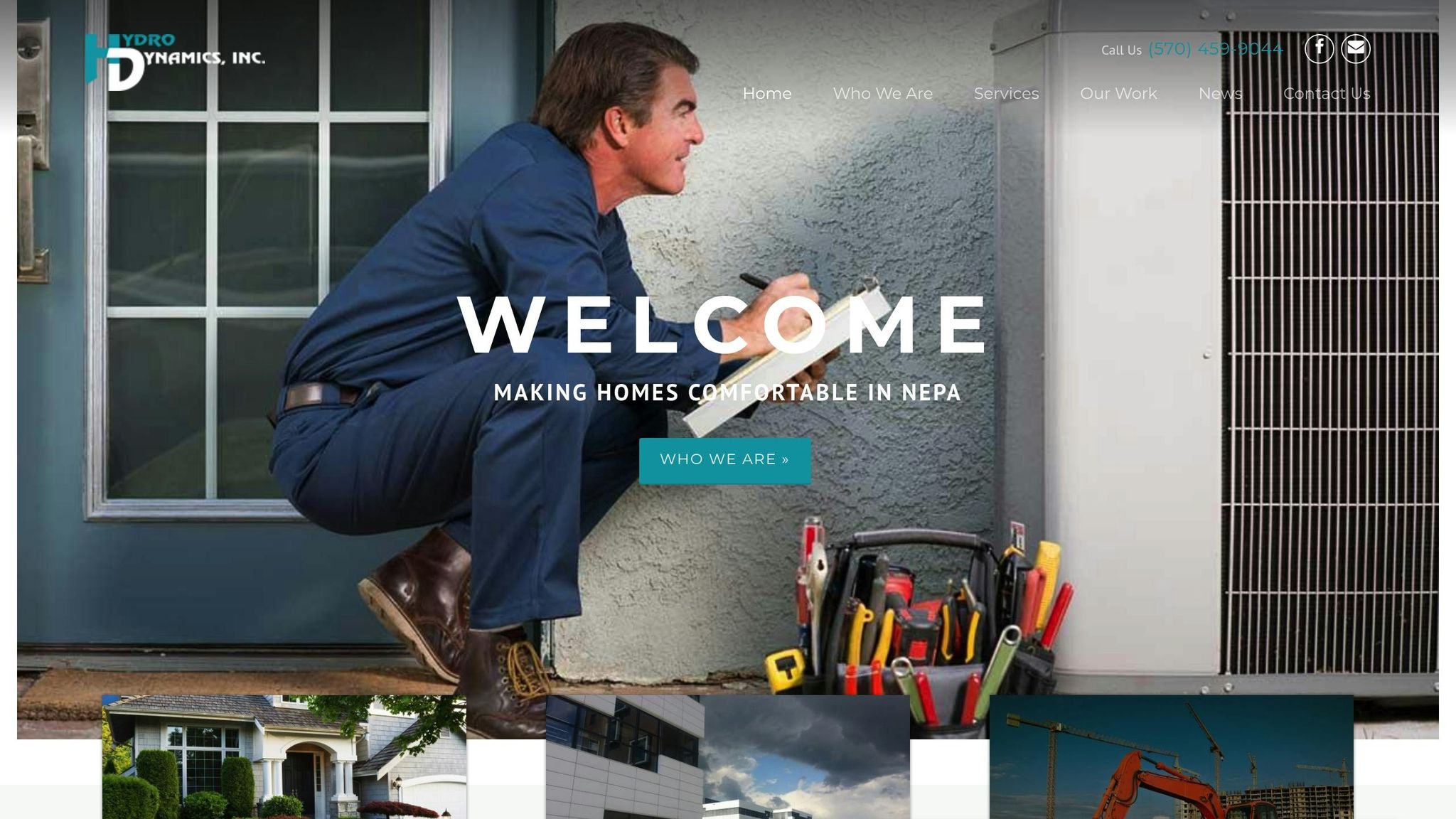
Hydrodynamics delivers top-tier thermostat repair and HVAC services across Northeastern Pennsylvania. Their certified technicians are equipped with advanced tools to diagnose and resolve complex issues like component failures, compatibility mismatches, and intricate wiring problems. They also offer preventive maintenance to address common concerns such as calibration drift.
Whether it’s a residential, commercial, or industrial property, Hydrodynamics understands that each setting has unique needs when it comes to thermostat performance. Plus, their 24/7 emergency service ensures you’re never left without heating or cooling, even during extreme weather conditions.
Their comprehensive approach includes evaluating thermostat placement, verifying compatibility with your HVAC system, and ensuring seamless integration to boost overall system performance and energy efficiency.
Conclusion: Thermostat Troubleshooting Summary
Fixing your HVAC thermostat can feel straightforward when you follow a step-by-step process. This guide has outlined the key actions to help you identify and address the most common thermostat problems.
Start with the essentials: reset your thermostat, replace the batteries if necessary, and clean out dust or corrosion from the internal components. These simple steps often resolve many issues and set the stage for further troubleshooting if needed.
If the basics don’t work, inspect the wiring connections. Loose or corroded terminals are a frequent culprit behind thermostat malfunctions.
To ensure your thermostat provides accurate temperature readings, compare its display with a reliable thermometer. Also, make sure it’s installed in the right spot – away from direct sunlight, heat sources, or drafts that could skew its performance.
Scheduling bi-annual HVAC servicing is another smart move. Regular maintenance helps catch problems like worn-out parts or electrical issues early, extending your system’s lifespan, which typically ranges from 10 to 15 years. However, even with consistent upkeep, some issues will require a professional touch.
If you’ve gone through these steps and the problem persists – or if you encounter electrical wiring concerns – it’s best to call in a qualified HVAC technician. They have the expertise to diagnose and repair complex issues that go beyond what DIY fixes can handle.
FAQs
What can I do if resetting my thermostat doesn’t solve the problem?
If adjusting your thermostat doesn’t resolve the problem, the next step is to check the circuit breaker. A tripped breaker could be cutting power to your thermostat, so make sure it’s in the correct position. For battery-operated thermostats, replacing the batteries is a simple way to rule out power-related issues.
You’ll also want to examine the wiring connections. Look for any loose or damaged wires and ensure everything is securely in place. If your thermostat has a system switch, double-check that it’s set to the appropriate mode, whether that’s heating or cooling.
Still having trouble? Try rebooting the thermostat – sometimes a quick reset can do the trick. If that doesn’t help, refer to your HVAC system’s manual for more troubleshooting tips. However, if the issue continues, it might be a sign of a more serious fault in the system. At that point, it’s best to call in a professional HVAC technician to diagnose and fix the problem.
How do I know if my thermostat is placed in the right location for accurate performance?
Why Thermostat Placement Matters
Where you install your thermostat greatly impacts how well it works. To get the best performance, place it in a central spot, away from anything that could block airflow, like furniture or curtains. Steer clear of areas with direct sunlight, drafts, or heat sources such as vents, radiators, or kitchen appliances. These factors can throw off the readings. Similarly, spots near windows, doors, or exterior walls – where temperatures can shift – aren’t ideal either. A well-placed thermostat helps your HVAC system maintain a steady, comfortable temperature throughout your home.
When should I call a professional for thermostat issues?
If your thermostat is completely unresponsive, keeps resetting itself, or troubleshooting doesn’t resolve the issue, it’s time to call a professional HVAC technician. Other warning signs, like persistent temperature fluctuations or error messages on the thermostat display, also point to the need for expert help.
Suspecting wiring issues or calibration problems? These are best handled by a trained technician to ensure your HVAC system runs safely and efficiently. Tackling these problems quickly can prevent more serious damage to your system down the line.


